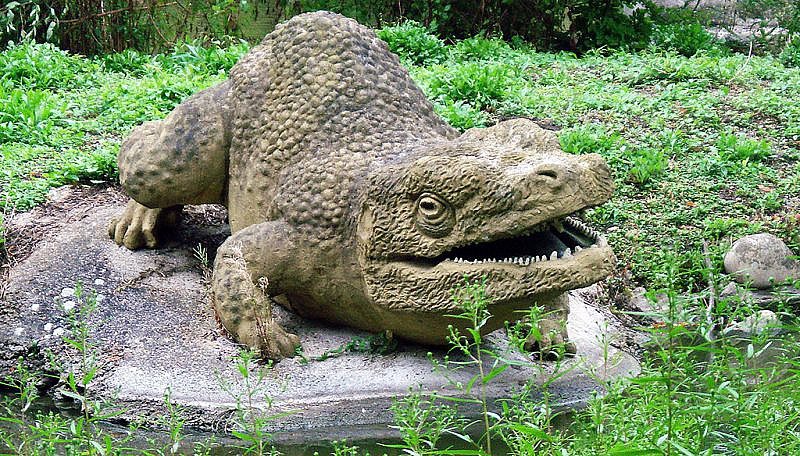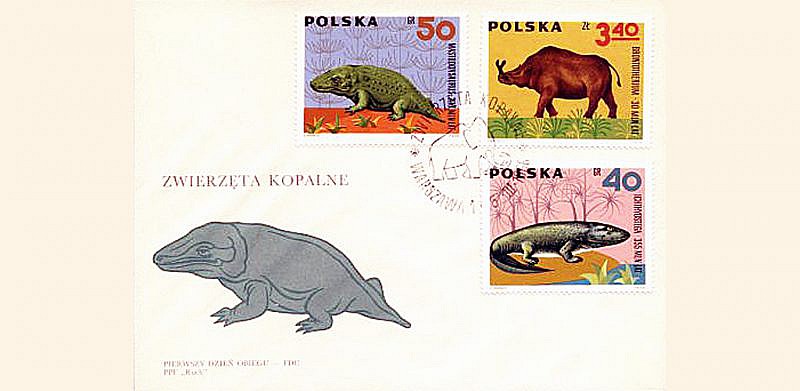Early Mastodonsaurus Life Reconstructions
The «labyrinthodont» amphibian Mastodontosaurus JAEGER, 1828 [Labyrinthodon OWEN, 1842 (1842a-c)], a giant Mesozoic temnospondyl, was at first reconstructed for a long time as enormous toad or frog with the mouth and dentition of a lizard.
Compare the detail from a figure of FIGUIER (1863) above and the life reconstruction made before 1854 by Benjamin Waterhouse Hawkins in agreement with Richard Owen for the Crystal Palace Park in South London further down.
Moreover, Mastodonsaurus was once thought to be responsible for the footprints (tracks) found in Triassic sandstones and described as Chirotherium KAUP, 1835 who himself believed that they were of mammalian origin. Chirotherium (= hand-beast) is in use for a very particular and typical trace fossil whose imprints have the outlines of a foot with its supposed big toe abduct (see small grey picture above). More recent research has found that the tracks belong to crocodile-like pseudosuchian reptiles and that not the first but the fifth digit was braced by the trackmaker (BOWDEN, TRESISE & SIMKISS 2010, KREBS 1963, 1973, SWINTON 1961).

Below, there is a relatively modern life-reconstruction of Mastodonsaurus from the 1960s. Although this illustration is more down-to-earth than those above, it is likewise not scientifically accurate and thus historic itself from today’s perspective as latest examinations of the skeletal material have shown (DAMIANI 2001, MOSER & SCHOCH 2007, SCHOCH 1999).
DAMIANI, R.J. (2001): A systematic revision and phylogenetic analysis of Triassic mastodonsauroids (Temnospondyli: Stereospondyli). Zoological Journal of the Linnean Society 133 (4): 379-482.
FIGUIER, L. (1863): La terre avant le déluge: Ouvrage contenant 24 vues idéales de paysages de l’ancien monde dessinées par Riou, 486 pp.
JAEGER, G.F. (1828): Über die fossile Reptilien, welche in Württemberg aufgefunden worden sind, 48 pp.
KAUP, J.J. (1835): Mittheilungen, an Professor Bronn gerichtet. Thier-Fährten von Hildburghausen: Chirotherium oder Chirosaurus. Neues Jahrbuch für Mineralogie, Geognosie, Geologie und Petrefaktenkunde 1835: 327-328
KREBS, B. (1963): Bau und Funktion des Tarsus eines Pseudosuchiers aus der Trias des Monte San Giorgio (Kanton Tessin, Schweiz). – Paläontologische Zeitschrift 37 (1/2): 88-95.
KREBS, B. (1973): Der Tarsus von Rauisuchus (Pseudosuchia, Mittel-Trias). – Mitteilungen der bayerischen Staatssammlung für Paläontologie und historische Geologie 13: 95-101.
MOSER, M. & SCHOCH, R. (2007): Revision of the type material and nomenclature of Mastodonsaurus giganteus (Jaeger) (Temnospondyli) from the middle Triassic of Germany. Palaeontology 505: 1245-1266.
OWEN, R. (1842a): Report on British fossil reptiles, part II: Report of the eleventh meeting of the British Association for the Advancement of Science; held at Plymouth in July 1841 1842: 60–204.
OWEN, R. (1842b): On the teeth of a species of the genus Labyrinthodon (Mastodonsaurus of Jaeger), common to the German Keuper Formation and the Lower Sandstone of Warwick and Leamington. Transactions of the Geological Society of London 2Ser. 6: 503–514.
OWEN, R. (1842c): Description of parts of the skeleton and teeth of five species of the genus Labyrinthodon, from the New Red Sandstone of Coton End and Cubbington quarries; with remarks on the probable identity of Cheirotherium with this genus of extinct batrachians. Transactions of the Geological Society of London 2Ser. 6: 515–544.
SCHOCH, R.R. (1999): Comparative osteology of Mastodonsaurus giganteus (Jaeger, 1828) from the Middle Triassic (Lettenkeuper: Longobardian) of Germany (Baden-Württemberg, Bayern, Thüringen). Stuttgarter Beiträge zur Naturkunde B 278: 1–175.
SWINTON, W.E. (1961): The history of Chirotherium. Geological Journal 2 (3): 443–473. doi:10.1002/gj.3350020309


